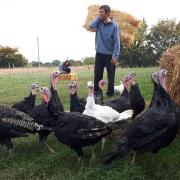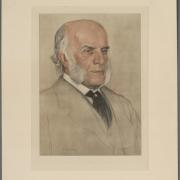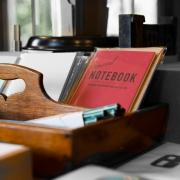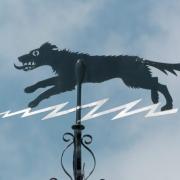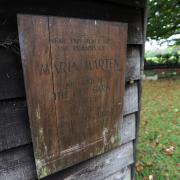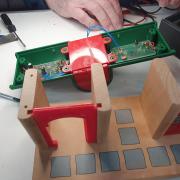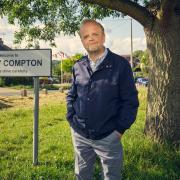Over 85 years ago, one of the UK’s greatest archaeological discoveries was unearthed from an unassuming mound at Sutton Hoo in Suffolk.
The discovery changed history. It went on to become the richest burial ever found in northern Europe and was heralded as England’s own ‘Valley of the Kings’, drawing comparison with the discovery of Tutankhamun’s tomb some 17 years earlier.
Now, eight decades on, excitement is building as some of the country's most famous archaeologists return to the area.
Earlier this year, the National Trust’s Sutton Hoo announced a new two-year research partnership with Time Team, the British archaeology series that has been watched by millions across the globe.

The programme launched on the UK’s Channel 4 in 1994 and ran for 20 series, becoming one of the country’s biggest supporters of archaeology and enjoying unrivalled access to some of the nation’s most celebrated landmarks, including Westminster Abbey, Buckingham Palace and Windsor Castle.
The show returned in 2021, this time on YouTube, and is now supported by thousands of fans through the online membership platform Patreon. Following the announcement in March, fans have expressed their delight, and excitement, about Sutton Hoo’s upcoming dig.
'The words "Sutton Hoo", "Time Team" and "excavation" together conjure something rather magical,' says Laura Howarth, archaeology and engagement manager at Sutton Hoo.
'We are delighted to welcome back Time Team and we look forward to discovering and writing the latest chapters in the Sutton Hoo story. That visitors will be able to come and watch the excavation unfold is an added bonus.'

The dig itself will take place over four weeks in June and focus on a different, lesser-known area of the site – not the Royal Burial Ground, which was the subject of the 1939 dig, but Garden Field, a large area of grass nestled beside the attraction’s visitor centre.
During construction of this in 2000, the National Trust discovered the remains of another Anglo-Saxon cemetery.
Home to the previously discovered Bromeswell Bucket, archaeologists from Suffolk County Council’s archaeology unit went on to find 13 cremations and nine burials, five of which were hidden under small burial mounds.
While these were not quite as grand as the ship burials discovered in 1939, they still revealed fascinating details about Anglo-Saxon life.

Women had been buried with everyday items such as combs, bowls, brooches and beads, while many of the male graves also held spears and shields. These painted a particular picture of life at the time, of part-time warriors of low to relatively high status families, ready to take up arms – although they actually spent most of their lives farming the land.
Time Team carried out further research in 2021 and 2022, which revealed some ‘mysterious’ features in the landscape. What these are, nobody knows, but it’s hoped that June’s excavation will greatly improve our understanding.
'Garden Field has an extraordinary amount of archaeology in it, from prehistoric fields and possible burial mounds, right through to Roman settlements and an Anglo-Saxon cemetery,' says Angus Wainwright, regional archaeologist for the National Trust. 'But who knows what else may be hidden there?
'We know from previous work that it’s likely we’ll find prehistoric flint tools and fragments of Anglo-Saxon objects from burials scattered through the plough soil, but working out what the mysterious geophysical anomalies are will be our focus.

'We also hope to find evidence of the deep-time prehistory of Sutton Hoo and perhaps more information about the Anglo-Saxon cemetery, which we first discovered in 2000, when we were building the visitor centre.'
Angus says the approach will be 'painstaking'. The team will be recording all the finds in 3D from the ground surface, right down through the plough soil, until they reach the undisturbed archaeology below.
Day to day, the dig will be supported by Field Archaeological Specialists (FAS) and it will also involve members of the 1980s archaeological team, who carried out subsequent digs on the Royal Burial Ground, culminating in the excavation of a second ship burial and a warrior’s resting place.
Tim Taylor, Time Team’s series producer and creator, says they’re thrilled to be joining forces with the National Trust site, which has become so important to British archaeology. 'We are incredibly thrilled to expand our relationship with Sutton Hoo, delving deeper into the history of one of Britain’s most iconic sites,' he says.

'The story of Sutton Hoo has captured the world’s imagination, as we can see by the success of the award-winning film The Dig, and we hope this will reveal yet another exciting chapter.'
The National Trust will be working with archaeology volunteers throughout the dig, with volunteers assisting with hands-on ‘digging’ and processing finds. Visitors will also be able to see the dig in person and learn more about the history of the site when they visit in June.
Throughout, Time Team will also be documenting the investigation, culminating in a documentary special presented by Sir Tony Robinson, who presented the original Channel 4 show. A further Time Team documentary, already in development, will explore the ongoing reconstruction of the Great Burial Ship, which is being carried out by the Sutton Hoo Ship’s Company, on the other side of the river.
To find out more, visit nationaltrust.org.uk/sutton-hoo
Archaeology at Sutton Hoo
1600s: Tudor treasure-seekers excavate the mounds at Sutton Hoo. They miss the contents of at least two of them, which leaves them undisturbed for the future.
1860: Further excavations take place. Little is found except a large quantity of rivets, which are allegedly passed on to a local blacksmith to forge horse shoes.
1938: Landowner Edith Pretty appoints Basil Brown to begin excavating the mounds at the Royal Burial Ground. Although many have already been plundered, he finds a few items which hint at things to come, including pieces of pottery, a gilt bronze disc and the tip of a sword blade.
1939: Basil Brown returns to Sutton Hoo in May and begins work on Mound One. Along with a team led by Charles Philips, they uncover the ghost of the Great Ship Burial, along with 263 further finds of gold, garnet, silver, bronze, enamel, iron, wood, bone, textile, feathers and fur, plus fragments of what later become known as the famous Sutton Hoo helmet.
1965-1971: Rupert Bruce-Mitford, Paul Ashbee and a team from the British Museum return to Sutton Hoo. After further analysis, they conclude that the acid in the soil dissolved the timbers and human remains of the Great Ship Burial.
1983-1993: Archaeologist Martin Carver begins work on other areas of the Royal Burial Ground. He eventually unearths a second ship burial and a warrior’s burial complete with his sacrificed horse.
1986: Harrowing in Garden Field reveals fragments of the Byzantine Bucket, thought to date back to the 6th century.
2000: Areas of Garden Field are further excavated to make way for Sutton Hoo’s new visitor centre. Another Anglo-Saxon cemetery is discovered.
2017: New technologies, such as ground penetrating radar and drone-mounted laser (LiDAR) are used on the mounds at the Royal Burial Ground.
2021-2022: Time Team conducts further surveys of the Royal Burial Ground and Garden Field. Information from this is used to plan the new excavation to take place in June 2024.




